颜色词的英汉差异及翻译论文
- 格式:doc
- 大小:25.00 KB
- 文档页数:6
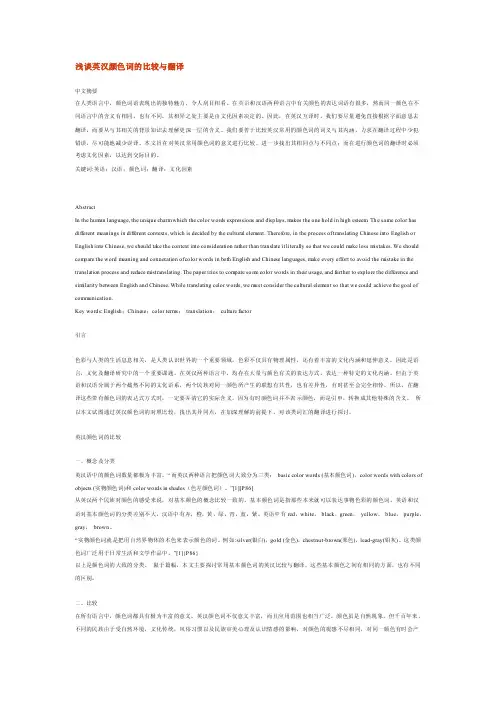
浅谈英汉颜色词的比较与翻译中文摘要在人类语言中,颜色词语表现出的独特魅力,令人刮目相看。
在英语和汉语两种语言中有关颜色的表达词语有很多,然而同一颜色在不同语言中的含义有相同,也有不同,其相异之处主要是由文化因素决定的。
因此,在英汉互译时,我们要尽量避免直接根据字面意思去翻译,而要从与其相关的背景知识去理解更深一层的含义。
我们要善于比较英汉常用的颜色词的词义与其内涵,力求在翻译过程中少犯错误,尽可能地减少误译。
本文旨在对英汉常用颜色词的意义进行比较,进一步找出其相同点与不同点;而在进行颜色词的翻译时必须考虑文化因素,以达到交际目的。
关键词:英语;汉语;颜色词;翻译;文化因素AbstractIn the human language, the unique charm which the color words expressions and displays, makes the one hold in high esteem. Th e same color has different meanings in different contexts, which is decided by the cultural element. Therefore, in the process of translating Chinese into English or English into Chinese, we should take the context into consideration rather than translate it literally so that we could make less mistakes. We should compare the word meaning and connotation of color words in both English and Chinese languages, make every effort to avoid the mistake in the translation process and reduce mistranslating. The paper tries to compare so me color words in their usage, and further to explore the difference and similarity between English and Chinese. While translating color words, we must consider the cultural element so that we could achieve the goal of communication.Key words: English;Chinese;color terms;translation;culture factor引言色彩与人类的生活息息相关,是人类认识世界的一个重要领域。
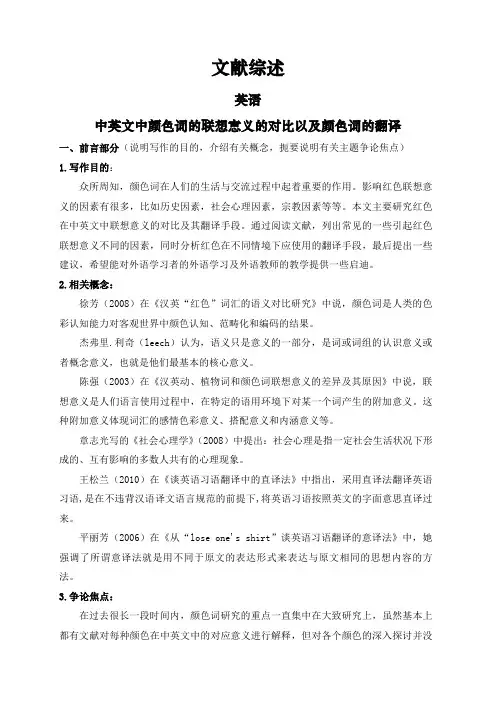
文献综述英语中英文中颜色词的联想意义的对比以及颜色词的翻译一、前言部分(说明写作的目的,介绍有关概念,扼要说明有关主题争论焦点)1.写作目的:众所周知,颜色词在人们的生活与交流过程中起着重要的作用。
影响红色联想意义的因素有很多,比如历史因素,社会心理因素,宗教因素等等。
本文主要研究红色在中英文中联想意义的对比及其翻译手段。
通过阅读文献,列出常见的一些引起红色联想意义不同的因素,同时分析红色在不同情境下应使用的翻译手段,最后提出一些建议,希望能对外语学习者的外语学习及外语教师的教学提供一些启迪。
2.相关概念:徐芳(2008)在《汉英“红色”词汇的语义对比研究》中说,颜色词是人类的色彩认知能力对客观世界中颜色认知、范畴化和编码的结果。
杰弗里.利奇(leech)认为,语义只是意义的一部分,是词或词组的认识意义或者概念意义,也就是他们最基本的核心意义。
陈强(2003)在《汉英动、植物词和颜色词联想意义的差异及其原因》中说,联想意义是人们语言使用过程中,在特定的语用环境下对某一个词产生的附加意义。
这种附加意义体现词汇的感情色彩意义、搭配意义和内涵意义等。
章志光写的《社会心理学》(2008)中提出:社会心理是指一定社会生活状况下形成的、互有影响的多数人共有的心理现象。
王松兰(2010)在《谈英语习语翻译中的直译法》中指出,采用直译法翻译英语习语,是在不违背汉语译文语言规范的前提下,将英语习语按照英文的字面意思直译过来。
平丽芳(2006)在《从“lose one's shirt”谈英语习语翻译的意译法》中,她强调了所谓意译法就是用不同于原文的表达形式来表达与原文相同的思想内容的方法。
3.争论焦点:在过去很长一段时间内,颜色词研究的重点一直集中在大致研究上,虽然基本上都有文献对每种颜色在中英文中的对应意义进行解释,但对各个颜色的深入探讨并没有与时俱进并且提高。
人们逐渐认识到颜色词出现在生活中的频率增加,与自己的生活与交流息息相关。
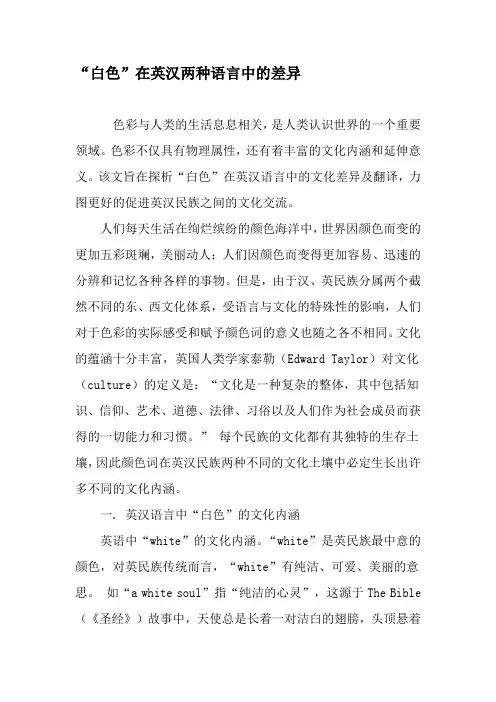
“白色”在英汉两种语言中的差异色彩与人类的生活息息相关,是人类认识世界的一个重要领域。
色彩不仅具有物理属性,还有着丰富的文化内涵和延伸意义。
该文旨在探析“白色”在英汉语言中的文化差异及翻译,力图更好的促进英汉民族之间的文化交流。
人们每天生活在绚烂缤纷的颜色海洋中,世界因颜色而变的更加五彩斑斓,美丽动人;人们因颜色而变得更加容易、迅速的分辨和记忆各种各样的事物。
但是,由于汉、英民族分属两个截然不同的东、西文化体系,受语言与文化的特殊性的影响,人们对于色彩的实际感受和赋予颜色词的意义也随之各不相同。
文化的蕴涵十分丰富,英国人类学家泰勒(Edward Taylor)对文化(culture)的定义是:“文化是一种复杂的整体,其中包括知识、信仰、艺术、道德、法律、习俗以及人们作为社会成员而获得的一切能力和习惯。
” 每个民族的文化都有其独特的生存土壤,因此颜色词在英汉民族两种不同的文化土壤中必定生长出许多不同的文化内涵。
一. 英汉语言中“白色”的文化内涵英语中“white”的文化内涵。
“white”是英民族最中意的颜色,对英民族传统而言,“white”有纯洁、可爱、美丽的意思。
如“a white soul”指“纯洁的心灵”,这源于The Bible (《圣经》)故事中,天使总是长着一对洁白的翅膀,头顶悬着银白色的光环。
又如在经典芭蕾舞剧“Swan Lake”(《天鹅湖》)中的白天鹅“white swan”带有善良、纯洁和美好的涵义。
在经济生活中“white”有多种内涵。
白色作为一种纯洁而高贵的色彩,一直以来都是一种流行趋势,在欧洲、北美,澳洲等地区,白色消费笔记本已成为时尚的代言人。
此外化妆品、电器、汽车等一系列高雅的白色包装设计的产品在世界范围刮起了一场白色风暴;“white war”经济竞争,“white sale”大减价,“white money”银币。
英民族文化里存在重视“white”的传统,但在一定场合中它可用作贬义。
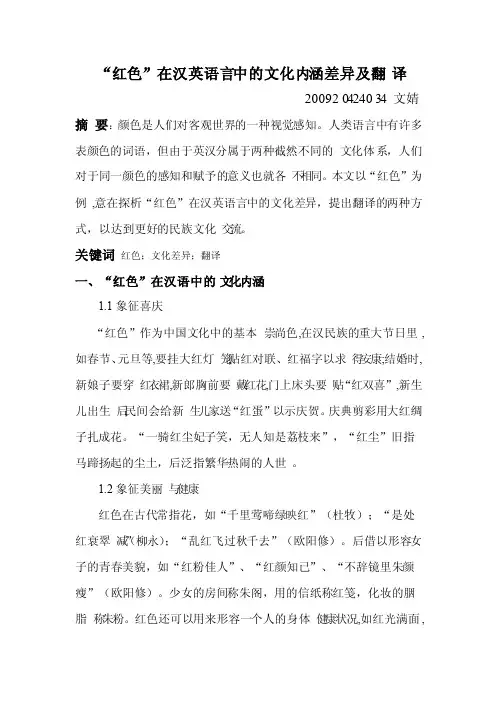
“红色”在汉英语言中的文化内涵差异及翻译200920424034 文婧摘要:颜色是人们对客观世界的一种视觉感知。
人类语言中有许多表颜色的词语,但由于英汉分属于两种截然不同的文化体系,人们对于同一颜色的感知和赋予的意义也就各不相同。
本文以“红色”为例,意在探析“红色”在汉英语言中的文化差异,提出翻译的两种方式,以达到更好的民族文化交流。
关键词红色;文化差异;翻译一、“红色”在汉语中的文化内涵1.1象征喜庆“红色”作为中国文化中的基本崇尚色,在汉民族的重大节日里,如春节、元旦等,要挂大红灯笼,贴红对联、红福字以求得安康;结婚时,新娘子要穿红衣裙,新郎胸前要戴红花,门上床头要贴“红双喜”,新生儿出生后,民间会给新生儿家送“红蛋”以示庆贺。
庆典剪彩用大红绸子扎成花。
“一骑红尘妃子笑,无人知是荔枝来”,“红尘”旧指马蹄扬起的尘土,后泛指繁华热闹的人世。
1.2象征美丽与健康红色在古代常指花,如“千里莺啼绿映红”(杜牧);“是处(柳永);“乱红飞过秋千去”(欧阳修)。
后借以形容女红衰翠减”子的青春美貌,如“红粉佳人”、“红颜知已”、“不辞镜里朱颜瘦”(欧阳修)。
少女的房间称朱阁,用的信纸称红笺,化妆的胭脂称朱粉。
红色还可以用来形容一个人的身体健康状况,如红光满面,红润的脸颊。
1.3象征兴旺和发达汉语中的“红色”可象征事业的兴旺、发达、顺利、成功等含义。
古代朝廷官员都住在“朱门”。
人的境遇好时被称为“红运当头”;生意好称为“生意红火”;得到上司宠爱的人叫“红人”;分到利润叫“分红”,给人发的奖金叫“红包”等等。
1.4象征革命和社会主义“红色”在中国具有浓重、鲜明的政治色彩:中华人民共和国国旗和中国共产党党旗都是红色,象征着“革命和无产阶级事业”,具有“忠贞和进步”的褒义联想。
![[英语论文]论颜色词在英汉双语中的使用](https://uimg.taocdn.com/8af5689d6429647d27284b73f242336c1fb93047.webp)
论颜色词在英汉双语中的使用摘要:本文采用对比的手法探讨了英汉两种语言中颜色词的差异,说明由于民族历史、社会制度、道德信仰等方面的差异,颜色的表示方法和使用也有很多的不同,对同一种颜色词的理解也有很大差别。
因此,了解并掌握颜色词及其所构成词汇,对跨文化研究与交流有一定的实际意义。
关键词:颜色词;差异;意义;颜色词,顾名思义,就是语言中承担描述色彩作用的词汇。
中英两种语言之中,都有大量的颜色词存在。
在汉语中有红、橙、黄、绿、白、黑、蓝、紫、灰,在英语中也有red, orange, yellow, green, white, black, blue, purple, gray与之相对应。
乔姆斯基在“句法要略”中提出:“语言的一种基本属性在于语言提供各种手段来表达无穷无尽的思想和无止境的新的情景下作出的适宜的反映”。
这便是说明了语言具有创造性的本质,也就决定了词汇可以根据不同的条件表达各种的意义。
对于颜色词来说也不例外。
由于受到民族文化、社会制度、道德信仰、文化艺术、风俗习惯、价值观念、思维方式、生活方式以及地域风貌等等差别的影响,人们对于颜色的客观理解也就呈现出千差万别的景象。
一、英汉两种语言中对同种颜色词的不同理解中华民族崇红尚黄。
就红、黄两种颜色来说,中西方的理解就存在着很大的差别。
中国人尚红,来源于对太阳的崇拜,认为红色代表着喜庆、吉祥、成功、忠诚和兴旺。
所以在中国的传统婚礼上,新人穿红袍,盖红盖头,点红蜡烛。
象征着今后的日子会充满幸福和喜悦。
在现代的词汇中,“红包”是奖励和祝福,“红利”是利润,“红颜”指代年轻和美貌。
再说三国时期的著名武将——关羽,书上说其是“面如重枣”,表明其耿直,忠诚的性格。
所以也就有了“千里走单骑”的壮举,为古今人们所传诵。
而在西方,因为红色是与血和火有关的颜色,red常常用做贬义,它代表的是灾祸、血腥等含义。
如:red-hands 血腥的手——杀人的手;be caught red-handed 当场被捕(被捉个现行); red-neck 乡巴佬,即受美国北方人所歧视的美国南部的农民。
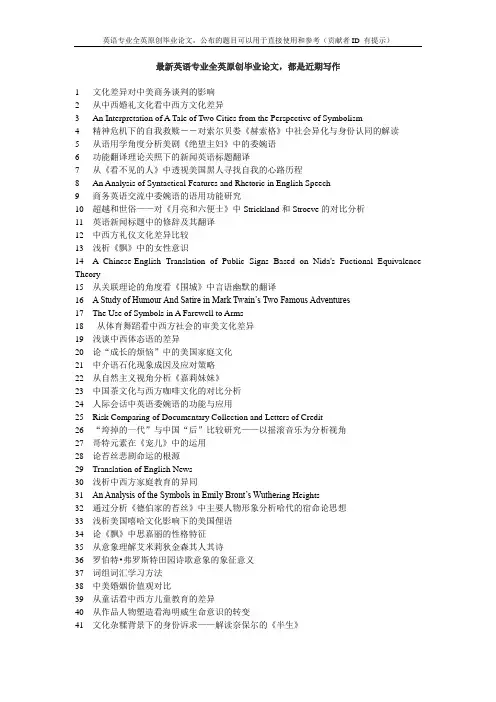
最新英语专业全英原创毕业论文,都是近期写作1 文化差异对中美商务谈判的影响2 从中西婚礼文化看中西方文化差异3 An Interpretation of A Tale of Two Cities from the Perspective of Symbolism4 精神危机下的自我救赎--对索尔贝娄《赫索格》中社会异化与身份认同的解读5 从语用学角度分析美剧《绝望主妇》中的委婉语6 功能翻译理论关照下的新闻英语标题翻译7 从《看不见的人》中透视美国黑人寻找自我的心路历程8 An Analysis of Syntactical Features and Rhetoric in English Speech9 商务英语交流中委婉语的语用功能研究10 超越和世俗——对《月亮和六便士》中Strickland和Stroeve的对比分析11 英语新闻标题中的修辞及其翻译12 中西方礼仪文化差异比较13 浅析《飘》中的女性意识14 A Chinese-English Translation of Public Signs Based on Nida's Fuctional Equivalence Theory15 从关联理论的角度看《围城》中言语幽默的翻译16 A Study of Humour And Satire in Mark Twain’s Two Famous Adventures17 The Use of Symbols in A Farewell to Arms18 从体育舞蹈看中西方社会的审美文化差异19 浅谈中西体态语的差异20 论“成长的烦恼”中的美国家庭文化21 中介语石化现象成因及应对策略22 从自然主义视角分析《嘉莉妹妹》23 中国茶文化与西方咖啡文化的对比分析24 人际会话中英语委婉语的功能与应用25 Risk Comparing of Documentary Collection and Letters of Credit26 “垮掉的一代”与中国“后”比较研究——以摇滚音乐为分析视角27 哥特元素在《宠儿》中的运用28 论苔丝悲剧命运的根源29 Translation of English News30 浅析中西方家庭教育的异同31 An Analysis of the Symbols in Emily Bront’s Wuthe ring Heights32 通过分析《德伯家的苔丝》中主要人物形象分析哈代的宿命论思想33 浅析美国嘻哈文化影响下的美国俚语34 论《飘》中思嘉丽的性格特征35 从意象理解艾米莉狄金森其人其诗36 罗伯特•弗罗斯特田园诗歌意象的象征意义37 词组词汇学习方法38 中美婚姻价值观对比39 从童话看中西方儿童教育的差异40 从作品人物塑造看海明威生命意识的转变41 文化杂糅背景下的身份诉求——解读奈保尔的《半生》42 A Comparison of the English Color Terms43 译者主体性对翻译风格的影响分析44 国际商务谈判中的文化差异分析45 电视公益广告的多模态话语分析46 以学生为中心的英语词汇教学研究47 从王尔德喜剧中的花花公子形象解读王尔德信奉的纨绔主义48 论英语商务合同中状语从句的翻译49 论《红字》中海斯特的女性主义50 浅析英文电影在高中英语教学应用51 从中美管理方式的不同透析中西方文化差异与整合52 体态语在英语课堂教学中的运用研究53 《雾都孤儿》中的正邪儿童形象54 从文化差异角度来分析习语的翻译55 《野性的呼唤》中巴克的性格形成过程分析56 从曼诺林角度研究圣地亚哥形象57 中美鬼节文化的对比研究58 The U-shaped Narrative Structure in Great Expectations59 英语报刊新闻标题的特点及解读60 On Eliza’s Independent Awareness in Pygmalion61 从文化内涵的角度看汉语动物习语的英译62 浅析《看不见的人》中的第一人称叙述策略63 英汉数词的文化对比及其翻译64 英汉恭维语的对比研究65 功能目的论视角下的仿拟翻译的应用分析66 从语境视角分析电影字幕英译中翻译67 文化差异对商务谈判的影响及策略68 《德拉库拉》中病态感情和正常感情的对比和碰撞69 影响中学生学习英语的因素70 浅谈简•奥斯丁《劝导》的反讽艺术71 世纪年代鲁迅与梁实秋之间的翻译论战72 论反语的语用功能73 论口译的原则与技巧74 十九世纪英国女性小说中的两位灰姑娘——伊利莎白•班纳特和简•爱形象比较75 从《绝望主妇》看美国人的婚姻观76 A Study of Narrative Techniques in Barn Burning77 从违反合作原则研究《生活大爆炸》78 英汉礼貌用语及交际策略的对比分析79 The Study of Symbolism in Moby Dick80 《爱玛》中的女权思想解读81 浅析张培基的散文翻译风格82 西方骑士精神与中国侠义精神的比较研究—以《亚瑟王之死》和《水浒传》为例83 语音歧义和语义歧义的语言学分析84 中西方商务礼仪的差异85 目的论视角下《瓦尔登湖》两个中文译本的分析86 从《汤姆叔叔的小屋》看基督教对美国黑奴的精神救赎87 从涉外婚姻分析中西方文化差异88 语用模糊及语用功能89 沙博理《水浒传》译本中文化词的翻译90 一首平凡女性成长的赞歌—用“成长小说”理论来解读《简爱》91 从目的论的角度比较研究《茶馆》的两个英文译本92 任务型教学中策划对高级英语学习者写作任务完成效果的影响93 英汉新词理据对比研究94 通过电视广告看中美思维模式差异95 肯克西《飞越疯人院》的女性主义批评96 夏洛蒂•勃朗特《简•爱》中普通而独特的女性形象97 对圣经文学性之赏析98 新闻英语模糊语的语用功能分析99 英汉“悲伤”情感隐喻认知对比分析100 谈呼啸山庄的复仇主题101 试论《最蓝的眼睛》中黑人理想家庭的破灭102 功能对等理论视域下的商标名称汉译103 从对等功能理论看《卡斯特桥市长》中的比喻修辞104 Research on the Expression of the Speaker’s Intention in English and Chinese Conversation 105 美国总统就职演说中隐喻的语用功能分析106 从语用角度谈英汉称赞语及其回应策略107 中英基本颜色词比较和翻译108 The Theme of Absurdity in The Scarlet Letter109 析《麦田里的守望者》霍尔顿•考尔菲德的性格特征110 On the Disillusion of Gatsby's American Dream111 The Changes of Women’s Status in China and Western Countries112 试析托尼•莫里森《爱娃》中的魔幻现实主义113114 浅析《德伯家的苔丝》中两位男主人公115 The Pioneer of Romanticism----The Poems of William Wordsworth116 论《最后的莫西干人》中的印第安情结117 跨文化因素对字幕翻译的影响118 提高高中生英语听力的策略和技巧119 论商标名称汉英翻译中的合作原则120 中美企业广告文化对比研究121 国际快递公司的本土化战略122 高中英语课堂教学中的口语教学123 《了不起的盖茨比》的叙事技巧分析124 从语用角度谈英汉称赞语及其回应策略125 《人性的污点》中主要人物的悲剧命运与社会原因的分析126 《无名的裘德》主人公人物形象浅析127 从目的论看《红楼梦》中“狗”习语的翻译128 论《呼啸山庄》中的象征主义运用129 Research on the Re-creation in the Translation of the Trademarks in Different Cultures130 政治演说中名词性隐喻的认知研究131 非语言交际中体语的文化分析132 从传统节日庆祝方式的角度比较中英文化差异133 浅谈企业形象广告设计134 论英语称谓语中的性别歧视现象135 哥特元素在《宠儿》中的运用136 词块法在高中英语写作教学中的应用137 解析《飘》中斯嘉丽的女性主义思想在其婚姻中的体现138 从《一个干净明亮的地方》解析海明威的冰山理论139 适者生存—对《飘》中生存意识的探究140 旅游文本英译中的归化与异化141 A Comparison of the English Color Terms142 论《宠儿》中的美国黑人女性的悲剧成长143 论《梅丽迪安》中主人公梅丽迪安的觉醒144 庞德对李白诗的误读——《华夏集》诗学探微145 哈里的迷惘与自我救赎——《乞力马扎罗的雪》的哲学解读146 从《傲慢与偏见》的婚姻看妇女的社会地位147 英语新词特点研究——词汇学习和了解文化的有效途径148 网络英语词汇的构词特点149 戏仿和影射—《洛丽塔》中的互文性150 论中国古典诗歌意象和意境英译——基于萨皮尔-沃夫假说151 从合作原则的违反看小品“卖拐”中的幽默152 语境顺应视角下英语情景喜剧中幽默字幕翻译--以《生活大爆炸》为例153 浅析《老人与海》中的悲剧色彩154 英语广告双关语的语用功能155 歧义的语用研究156 归化和异化在影片名翻译中的应用157 商务英语中含蓄否定句的研究158 A Funeral of Red Roses:An Analysis of Du Shiniang's and Marguerite Gautier's Tragedies from the Perspective of Human Dignity159 中学英语教学大纲与课程标准的比较研究160 做最好的自己—论斯佳丽形象对现代女性的教育意义161 论《金色笔记》的多元主题162 第二语言习得中语用迁移现象的分析163 跨文化交际中旅游英语菜式的翻译164 论“迷惘的一代”告别“美国梦”——浅谈《永别了,武器》和《了不起的盖茨比》165 论狄更斯《雾都孤儿》中南希的人物性格166 浅析《我们共同的朋友》中的象征手法167 《土生子》里的象征艺术168 A Comparative Study on Metaphors of FIRE between English and Chinese from a Cognitive Perspective169 从心理学角度看哈克贝利.费恩的性格170 网络英语的构词方式171 从原型批评理论角度分析威利洛曼的悲剧172 An Analysis of Jude’s Pursuit of Love in Jude the Obscure173 中西方饮料的跨文化差异174 房地产广告的英译研究175 An Analysis of David’ s Dual Personality in David Copperfield176 传统教法与交际法结合的英语教学探讨177 从女性主义视角看《抽彩》女主角的命运178 从以目的为导向的翻译原则看委婉语的翻译179 《杀死一只反舌鸟》文本和电影的比较研究180 The Similarities and the Differences between Gu Hongming and Lin Yutang 181 论《儿子与情人》中“花”的象征意义182 《哈利波特》系列里哈利波特与伏地魔的二元对立分析183 关于战争对英语习语的影响的研究184 An Analysis of Conflict Images in Invisible Man185 从《祝福》的英译本谈文化空缺词的翻译186 王尔德童话中的毁灭与拯救187 功能对等视角下英汉颜色词的对比与翻译188 麦当劳成功之道189 浅析《汤姆叔叔的小屋》中黑奴的命运190 中西饮食文化的差异191 从《瓦尔登湖》看“天人合一”与梭罗超验思想192 汉英颜色词的文化内涵及翻译193 英汉缩略语的比较与互译194 从电影《这个杀手不太冷》中看中西方文化差异195 从《麦琪的礼物》和《爱的牺牲》分析欧•亨利的写作特色196 浅析《老人与海》圣地亚哥的硬汉形象197 《最蓝的眼睛》和《宠儿》中黑人女性的悲剧根源198 The Symbols and Their Symbolic Meanings in The Scarlet Letter199 论新闻英语中的选词及其翻译200 (英语系经贸英语)浅析国际资本流动——以中国为例。
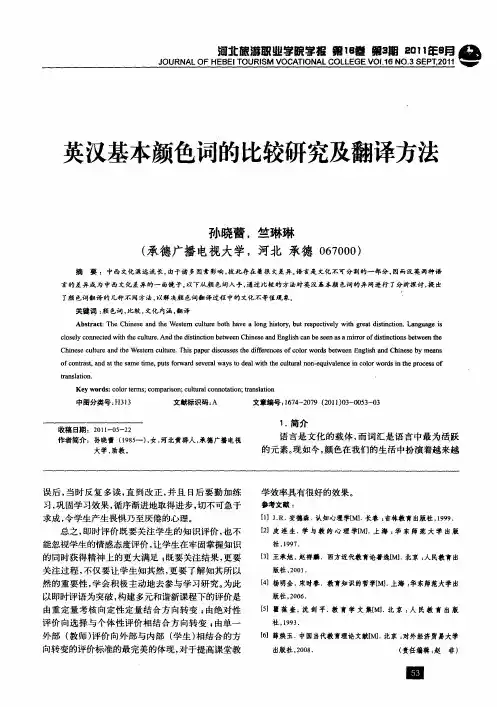
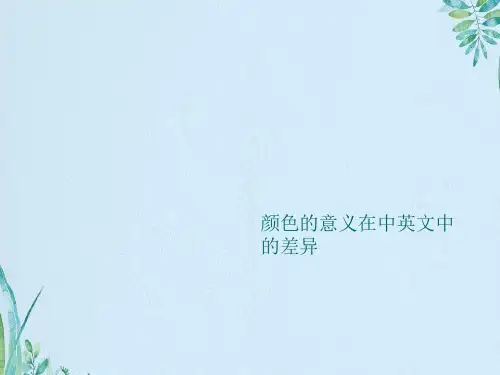
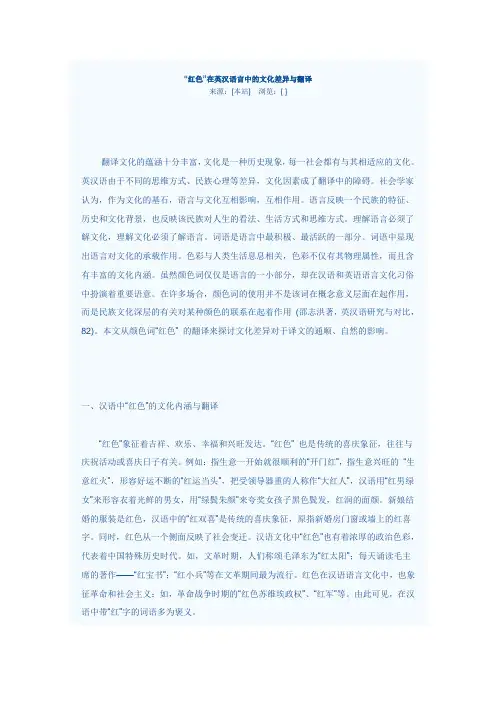
“红色”在英汉语言中的文化差异与翻译来源:[本站]浏览:[ ]翻译文化的蕴涵十分丰富,文化是一种历史现象,每一社会都有与其相适应的文化。
英汉语由于不同的思维方式、民族心理等差异,文化因素成了翻译中的障碍。
社会学家认为,作为文化的基石,语言与文化互相影响,互相作用。
语言反映一个民族的特征、历史和文化背景,也反映该民族对人生的看法、生活方式和思维方式。
理解语言必须了解文化,理解文化必须了解语言。
词语是语言中最积极、最活跃的一部分。
词语中显现出语言对文化的承载作用。
色彩与人类生活息息相关,色彩不仅有其物理属性,而且含有丰富的文化内涵。
虽然颜色词仅仅是语言的一小部分,却在汉语和英语语言文化习俗中扮演着重要语意。
在许多场合,颜色词的使用并不是该词在概念意义层面在起作用,而是民族文化深层的有关对某种颜色的联系在起着作用(邵志洪著,英汉语研究与对比,82)。
本文从颜色词“红色” 的翻译来探讨文化差异对于译文的通顺、自然的影响。
一、汉语中“红色”的文化内涵与翻译“红色”象征着吉祥、欢乐、幸福和兴旺发达。
“红色” 也是传统的喜庆象征,往往与庆祝活动或喜庆日子有关。
例如:指生意一开始就很顺利的“开门红”,指生意兴旺的“生意红火”,形容好运不断的“红运当头”,把受领导器重的人称作“大红人”,汉语用“红男绿女”来形容衣着光鲜的男女,用“绿鬓朱颜”来夸奖女孩子黑色鬓发,红润的面颜。
新娘结婚的服装是红色,汉语中的“红双喜”是传统的喜庆象征,原指新婚房门窗或墙上的红喜字。
同时,红色从一个侧面反映了社会变迁。
汉语文化中“红色”也有着浓厚的政治色彩,代表着中国特殊历史时代。
如,文革时期,人们称颂毛泽东为“红太阳”;每天诵读毛主席的著作——“红宝书”;“红小兵”等在文革期间最为流行。
红色在汉语语言文化中,也象征革命和社会主义:如,革命战争时期的“红色苏维埃政权”、“红军”等。
由此可见,在汉语中带“红”字的词语多为褒义。
二、英语中“red”的文化内涵与翻译在英语语言文化中,人们常常将红色与战争、血腥相联系。
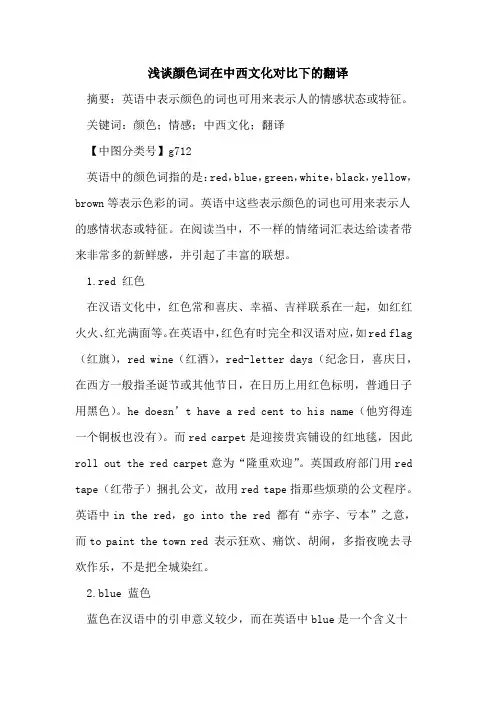
浅谈颜色词在中西文化对比下的翻译摘要:英语中表示颜色的词也可用来表示人的情感状态或特征。
关键词:颜色;情感;中西文化;翻译【中图分类号】g712英语中的颜色词指的是:red,blue,green,white,black,yellow,brown等表示色彩的词。
英语中这些表示颜色的词也可用来表示人的感情状态或特征。
在阅读当中,不一样的情绪词汇表达给读者带来非常多的新鲜感,并引起了丰富的联想。
1.red 红色在汉语文化中,红色常和喜庆、幸福、吉祥联系在一起,如红红火火、红光满面等。
在英语中,红色有时完全和汉语对应,如red flag (红旗),red wine(红酒),red-letter days(纪念日,喜庆日,在西方一般指圣诞节或其他节日,在日历上用红色标明,普通日子用黑色)。
he doesn’t have a red cent to his name(他穷得连一个铜板也没有)。
而red carpet是迎接贵宾铺设的红地毯,因此roll out the red carpet意为“隆重欢迎”。
英国政府部门用red tape(红带子)捆扎公文,故用red tape指那些烦琐的公文程序。
英语中in the red,go into the red 都有“赤字、亏本”之意,而to paint the town red 表示狂欢、痛饮、胡闹,多指夜晚去寻欢作乐,不是把全城染红。
2.blue 蓝色蓝色在汉语中的引申意义较少,而在英语中blue是一个含义十分丰富的词,常用来表示人情绪低落、心情沮丧、忧愁苦闷,如in a blue mood,blue devils,sing the blues等,都表示忧郁的意思。
blue在英语中有社会地位高、出身名门之意,如blue blood (出生名门望族)。
blue有时用来指“黄色的,下流的”意思,如blue talk(下流的言论)、blue video(黄色录像)。
此外,blue 还有许多别的意思,如:blue-collar worker指体力劳动者(蓝领)、once in a blue moon(偶尔,有时)、out of blue(意外,意想不到)、drink still all’s blue(一醉方休),在美国,编辑一般用蓝色铅笔改稿,故有作动词的:blue pencil。
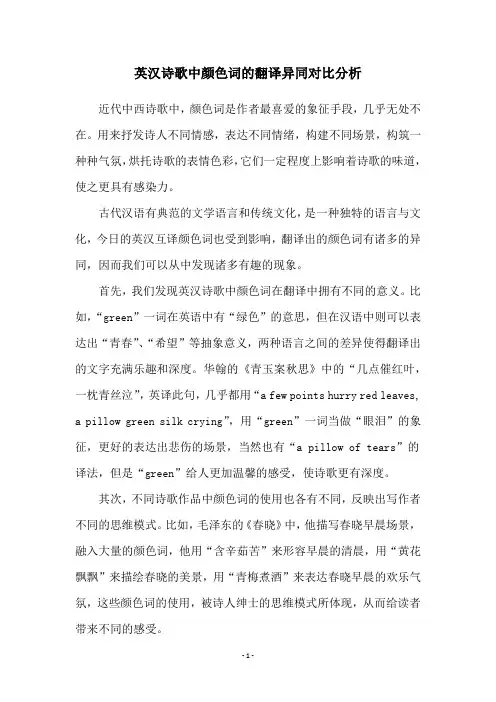
英汉诗歌中颜色词的翻译异同对比分析近代中西诗歌中,颜色词是作者最喜爱的象征手段,几乎无处不在。
用来抒发诗人不同情感,表达不同情绪,构建不同场景,构筑一种种气氛,烘托诗歌的表情色彩,它们一定程度上影响着诗歌的味道,使之更具有感染力。
古代汉语有典范的文学语言和传统文化,是一种独特的语言与文化,今日的英汉互译颜色词也受到影响,翻译出的颜色词有诸多的异同,因而我们可以从中发现诸多有趣的现象。
首先,我们发现英汉诗歌中颜色词在翻译中拥有不同的意义。
比如,“green”一词在英语中有“绿色”的意思,但在汉语中则可以表达出“青春”、“希望”等抽象意义,两种语言之间的差异使得翻译出的文字充满乐趣和深度。
华翰的《青玉案秋思》中的“几点催红叶,一枕青丝泣”,英译此句,几乎都用“a few points hurry red leaves, a pillow green silk crying”,用“green”一词当做“眼泪”的象征,更好的表达出悲伤的场景,当然也有“a pillow of tears”的译法,但是“green”给人更加温馨的感受,使诗歌更有深度。
其次,不同诗歌作品中颜色词的使用也各有不同,反映出写作者不同的思维模式。
比如,毛泽东的《春晓》中,他描写春晓早晨场景,融入大量的颜色词,他用“含辛茹苦”来形容早晨的清晨,用“黄花飘飘”来描绘春晓的美景,用“青梅煮酒”来表达春晓早晨的欢乐气氛,这些颜色词的使用,被诗人绅士的思维模式所体现,从而给读者带来不同的感受。
此外,英汉诗歌中颜色词的翻译也存在某种诗性的特点。
比如,英文的“yellow”一词,在汉语中可以翻译成“黄色”、“土黄”、“落霞”、“暮霭”等词,而汉文“青”一词,则可以翻译成“green”、“azure”、“jade”等词,各有其特定的审美意境,给读者以不同的情感体验,可以让读者更仔细地去体会诗人的描绘。
最后,英汉诗歌中颜色词的意义还可以延伸到其他文学领域,比如小说、戏剧中,颜色词实际上也是一种集体概念,它可以暗示人物的心理状态,描绘出场景的蓝图,或者暗示发展情节的前提和走向。
2019 9th International Conference on Social Science and Education Research (SSER 2019)The Semantic Contrast of Color Words between Chinese and English and TheirTranslationWenjia Wan1 and Yanfang Fan21************************************************************************2********************************************************Abstract. There are many color words in all kinds of languages in the world. In essence, color word is a symbol that conveys information with color language, and its connotation is the same for all nations in the world. However, due to the differences in living environment, geographical location and religious belief, there are considerable differences in the understanding and cognition of color words. Chinese and English cultures have a long history, and there are both similarities and great differences in the origin, development, semantic meaning and application of color words under two different cultural backgrounds. In this paper, the comparison and analysis from the perspective of language and culture background of English color words with meaning equivalence and differences and its translation, for some color words in chinese-english two languages as well as the similarities and differences of the language characteristics, cultural significance, and then expounds the understanding of the language vocabulary cannot be separated from specific language environment, so as to reach the correct understanding of words and transformation between different languages, to help us better understand and use the language and culture. Understanding and mastering these color words and the cultural differences they constitute is of practical significance for cross-cultural communication and translation activities.Key words: Color Words, Pragmatic Meaning, Comparative Analysi, Cultural Context1. IntroductionEnglish, like Chinese, has many words for color. Color words are symbols that use color language to convey information or express emotions [1]. Color has a kind of visual ability. Since human beings have the same visual nervous system, physiological mechanism and unified thinking, color words have a lot in common in language and culture, and their essence is the same for all nations [2]. However, given the location of each ethnic, cultural environment, living background, religious belief and cultural background, etc, the difference of different ethnic people in their own way of thinking dimensions to describe the color of something, and give yourself to color characteristics and connotation of national culture, thus the connotation of all sorts of color and the value given by the concept and in the application of language and culture is different [3]. Therefore, as long as there are differences in language and national culture, the additional, extended and associative meanings given by different national languages to colors cannot be consistent [4]. The national idiom meaning of chinese-english color words is the precipitation of Chinese and English national culture and history, which can not only reflect some regional characteristics and times changes, but also show that language is a mirror of national culture [5].In human life, the color of the word occupies a very important position. However, due to the different language and cultural habits and customs between English and Chinese, there are different ways to express colors and words, and even different understandings of the same color [6]. With the development and progress of human civilization, the vocabulary of color has been correspondingly enriched, and its meaning has derived many new meanings from the original simple expression of a certain color, thus making human language more vivid and colorful [7]. Only by understanding the background knowledge of English and Chinese culture and mastering the deep connotation of the words expressing colors in both languages can we carry out more effective and smooth communication and cooperation [8].From the perspective of language communication, language can express two levels of meaning, namely semantic meaning and pragmatic meaning. Semantic meaning is to express the sentence meaning independent of the language through language symbols according to the rules of a language, which can also be called the conceptual meaning or referential meaning of words [9]. Pragmatic meaning refers to the meaning of a word in a specific linguistic environment, sometimes referred to as contextual meaning [10]. The pragmatic meaning of words is different from the semantic meaning. Color word, as a word representing Color, must also have semantic meaning and pragmatic meaning in a specific context [11].By comparing the similarities and differences between Chinese and English color words, this paper makes a microscopic perspective on the differences between Chinese and English national cultures, and further analyzes the reasons for such differences, so as to explore and solve the problems arising from the translation of English and Chinese articles. At the same time, this paper also makes a comparison and analysis of the differences of the specific color words, namely "red", "yellow" and "blue", between Chinese and English.2.Method2.1 Equivalence Research Method of Linguistic Meaning AnalysisThe objectivity of things and the interconnectedness of human cognition make it possible for languages as cultural carriers to communicate, penetrate and transform with each other. The pragmatic meaning of the same color words in English and Chinese is sometimes the same, mainly in some foreign words. For example, white-collar refers to the mental worker corresponding to the manual worker. There is a black market in most cases. A green card allows foreigners to live and work in the United States. -blair: red lights. Driving through red lights means to give the green light to someone. ; The Blueprint: Blueprint; Detailed plan for doing anything detailed plan for doing anything detailed plan for doing anythingIn addition, this same aspect is also reflected in the Chinese and English language people from the color of the metaphor there is even a surprising similarity. In black and white; Call black and white. In addition, in terms of the meaning of color, Chinese and English color words also have a lot in common. For example,black refers to depression, guilt, illegality and sadness, etc. In English, there are black board,black list, black market and black heart. In Chinese, there are blackboards, blacklists, black markets and black hearts. Another example is red, which means "danger and celebration". Red alert, be in the red.Some color words can be used together to form phrases to express certain meanings. Equivalent words can be found in both Chinese and English languages. For example, "it's in white and black. Some phrases like "be black and blue allover" are black and blue allover; Not to distinguish black from white. Chinese and English differ slightly in the correspondence of color words, but their pragmatic meanings are roughly the same.2.2 Research Methods of Linguistic Meaning AnalysisEvery national language contains some words with social meaning, which is related to the cultural traditions and customs of the nation and the country that USES the language. Words in one language have cultural meanings that another language does not have due to different cultures, histories and customs. As an important part of language, color words have a common phenomenon of "non-correspondence" in cultural meaning. In a certain environment, a certain state of mind, the same color in the eyes of different people will have different color sense.Conflict of meaning, meaning something that China has, that Britain or some other country has, and has the equivalent word, but the meaning is very different. Reflected in the color words, the most obvious one is that the same pragmatic meaning is expressed in the two languages, but the semantic meaning of the use of different or even completely opposite color words. Here are some common examples :green eye; Black tea; Brown sugar. Pornographic or obscene films and jokes are"yellow movies and yellow jokes" in Chinese, while "blue movie, blue jokes" in English. The Chinese wore "wear white" to honor the deceased, while the British wore "wear black".3.ExperimentIn order to further study the similarities and differences in the translation of Chinese and English color words, this paper makes a comparative analysis on the specific application of "red, yellow and blue" in translation. The focus of this paper is the contrast between Chinese and English. Therefore, we only compare the language environment of China and the UK, and the comparison results are shown in table 1.Table parison of the connotations of red, yellow and blue in Chinese and EnglishRED YELLOW BLUECHINESE Enthusiasmred-bloodOrthodoxthe yellow robeBeautyblue sky or blueseaENGLISH Cruelred for dangerCowardly in a blue mood3.1 RED in Chinese and RED in EnglishIn both Chinese and western cultures, the bright red is often associated with happy and auspicious days and celebrations, expressing a warm, cheerful, enthusiastic, passionate and uplifting spirit. For example, in English, red-letter days generally refer to Christmas or happy days (calendars are often printed in red); Red-blood refers to a person who is energetic, athletic, and energetic. Red-hot means to drink too much; Roll out the red carpet for somebodyRed can be extended in both Chinese and western cultures to express people's excitement, excitement, shyness, anger and other emotional states. For example, He flushed red, not knowing how to express himself. (his red face, don't know how to express himself.) "Become red-faced" means to blush with shame. He turned red. He turned red. See red see red see red see red However, from the cultural tradition of bullfighting, westerners are deeply aware that "red" is red for danger, which means cruelty, fanaticism, disaster, tedium, blood, etc. Therefore, the red flag used by matadors to anger the bull is described as "something that makes people angry".3.2 YELLOW in Chinese and YELLOW in EnglishYellow, one of the five colors in China, is also called "earth color" or "positive color". As the color of "central, land and imperial dress", it symbolizes the meaning of orthodoxy, brightness and nobleness. Chinese people like to refer to themselves as "descendants of the Yellow Emperor". After the sui dynasty, yellow was made the official color of the emperor and it was forbidden for ordinary people to make clothes with it. Therefore, "the yellow robe" referred to the imperial robe. To be dressed with the imperial yellow robe by one's support and made emperor means to be the emperor.English "yellow" as a noun, in addition to "yellow, yellow, yolk, yellow clothes, yellow dye", there is also "yellow race" meaning; Used as adjectives, in addition to the "yellow, yellow race", also in spoken language used to describe "the cowardly, cowardly" (cowardly). The same can be said of "yellow-bellied" and "yellow-dog". Some nouns are named after their color. For example, yellow pages refers to the yellow phone book printed on yellow paper by americans. The Yellow Book, a report of the French government, is covered with yellow paper. Although some words have the word "yellow" in them, it is not related to "yellow" in English. For example, a lucky day, the nether world, an old man, a virgin.3.3 BLUE in Chinese and BLUE in EnglishBlue in the hearts of Chinese and British and American people are very charming, make people have infinite wonderful reverie, often used to describe the sky and the sea, show nature or people's open mind, for example. However, in English, people often use blue to describe people's feelings, with a derogatory meaning, which means "feeling down", "blue", "annoyed" and other unpleasant emotions. In a blue mood; He is (fall) in the blues. I'm black and blue. I'm black and blue. I'm not in a good mood because I had a really good weekend and I have to go to work or school on Monday.The word "blue-pencil" was originally used by editors of news, magazines, etc., to modify articles with a blue pen. Blue print refers to a blueprint printed by an old Blue printer. The term blueprint is now extended to include any design and detailed plans or schemes.4. Analysis and DiscussionWe can see that there are obvious differences in the use of color words between Chinese and English. Where English USES color words, Chinese does not necessarily use color words, and vice versa. On many occasions, it is not simply the superficial meaning of a certain color word that is at work, but the deep association of a certain color in the national culture that is at work. That is to say, when the color itself does not work, the difference in the use of color words in English and Chinese shows up. The main reasons for the differences in the use of color words between Chinese and English are as follows:4.1 Language ItselfThere are differences between English and Chinese in terms of language and word meaning. English word meaning is flexible while Chinese word meaning is fixed. Chinese words are precise, standard and rigorous, which has been regarded as illegal due to the variety of meanings. In the use of the green, for example, in English, green is associated with "environment", originated from Greenpeace (green peace organization), the organization was founded in 1971 in Canada, the original is a national anti-nuclear groups, develop into a influence after "conservationists international organization", due to human is becoming more and more attention to environmental and ecological, green in the 80 s has become a very active color words, and thus a greenish, the greens, etc. Green bureaucracygreen bureaucracygreen bureaucracygreen bureaucracygreen bureaucracysympathetic to the cause of the environment "Green peace" in Chinese is called "Green peace", but "Green" does not get a new meaning as in English. In other words, the word "green" in English has acquired a new meaning due to its association with green-peace. Without this collocation, the new meaning acquired by "green" may still exist independently. The Chinese word "green" only gets its collocation meaning when it is associated with "greenpeace". Without this collocation, the collocation meaning of "green" does not exist. This shows that the Chinese word meaning is relatively fixed, while the English word meaning is more flexible.4.2 Factors Beyond LanguageNon-linguistic factors refer to cultural factors including customs and cultural background. For example, "blue" means "undercooked" in English, but "blue" is not used in Chinese because English and Chinese view things from different angles. "Grey" in English means "old, sophisticated and mature", while "grey" in Chinese usually refers to "decadence, disappointment and ambiguous attitude". This is because the association between "grey" in English and "grey" in Chinese is different.Black pa mean in English based on undeclared income on the basis of part of the national economy, the Black refers to "illegal", "Black" although there is also a Chinese meaning such as the "secret, do not open", but by Black in Black pa "illegal" is associated with a particular economic system.Redneck redneck redneck redneck redneck redneck redneck redneck redneck redneck redneck redneck redneck redneck redneck redneck redneck redneck redneck redneck redneck redneckredneck redneck redneck In western culture, in the book of revelation of the bible, there is an adulteress "riding on a Scarlet beast" and wearing "Scarlet clothes", so later in western literature and culture, "Scarlet" is used to mean "lewdness". In English, 'scarlet woman' means' slut '. In the colonial period of North America, puritans used "scarlet letter" as a symbol of adultery. In Chinese, they used "green hat" to call people whose wives had affairs. This is not the case with green cap.The results of the study on factors other than language are shown in table 2 and figure 1. The data in the figure is sorted out according to the SPSS 7.2 logical index standard. The measurement results in this paper meet the requirements of P<0.005, and the study data are valid. In addition, British linguists also carried out a special study on this. They through the questionnaire and on-the-spot interviews, and reference data further analysis, in the Sino-British the influence factors of the differences of color words, cultural tradition of factors account for the vast majority of, about 49.8%, the reason is that transmission of ethnic culture is an important link between language and the different connotations of color words in Chinese and English shows that the two countries culture of homogeneity; The factors of religious belief account for 31.5%. The professors pointed out that, as a traditional Christian country, religious belief is reflected in every aspect of language in Britain, while the religious belief in China mostly focuses on Buddhism, Taoism and ancestor belief. The factors of social customs account for 16.6%. China and Britain have different social habits in the process of historical development, which is reflected in the connotation of color words. Other factors accounted for 2.1 percent.Table 2. Research results of factors other than languageFigure 1. Research results of factors other than language5.ConclusionIn this paper, by comparing the English color words appear in the translation process of the phase connectivity and difference of pragmatic meaning, and the "red, yellow, and blue" three words of the specific translation comparison, analyzing the problems in the semantic translation of color words, color words help us to further enhance the level of understanding and translation skills.Although the number of color words in the vocabulary of Chinese and English languages is limited, it reflects the cultural psychology and aesthetic taste of two different nations. Chinese and English two ancient languages have rich cultural connotation in their long social development process. The color words in them have unique symbolic meaning and can express different emotional colors. Color words not only have the dictionary, direct surface meaning, but also have the pragmatic meaning of cultural emotion. Therefore, in the process of learning English, it is of great significance for us to better understand the cultural background, customs and historical and geographical background of different color words in both English and Chinese.References[1]Yanwen W U, You X, Psychology D O. Is color words identification really not needed in attentional resources Evidence from the Stroop paradigm[J]. Acta Psychologica Sinica, 2017, 49(10):1267.[2]Harrison V, Reed L, Oraby S. Maximizing Stylistic Control and Semantic Accuracy in NLG: Personality Variation and Discourse Contrast[J]. 2019, 451(728):1783-1785.[3]Besner D, Reynolds M. Is semantic activation from print capacity limited? Evidence from the psychological refractory period paradigm[J]. Psychon Bull Rev, 2017, 24(3):907-913.[4]Kinoshita S, De Wit B, Norris D. The magic of words reconsidered: Investigating the automaticity of reading color-neutral words in the Stroop task.[J]. Journal of Experimental Psychology Learning Memory & Cognition, 2017, 43(3):12-16.[5]Mccarthy L M, Kalinyakfliszar M, Kohen F. Effects of semantic context on access to words of low imageability in deep-phonological dysphasia: a treatment case study.[J]. Aphasiology, 2017, 31(5):542.[6]Yamaguchi M, Clarke E L, Egan D L. Is Your Color My Color? Dividing the Labor of the Stroop Task Between Co-actors[J]. Frontiers in Psychology, 2018, 9(3):1407-1409.[7]Aldavert D, Rusinol M. Synthetically Generated Semantic Codebook for Bag-of-Visual-Words Based Word Spotting[J]. 2018, 43(81):223-228.[8]Dandois J, Baker M, Olano M. What is the Point? Evaluating the Structure, Color, and Semantic Traits of Computer Vision Point Clouds of Vegetation[J]. Remote Sensing, 2017, 9(4):355.[9]Jared D, Jouravlev O, Joanisse M F. The effect of semantic transparency on the processing of morphologically derived words: Evidence from decision latencies and event-related potentials.[J]. J Exp Psychol Learn Mem Cogn, 2017, 43(3):422-450.[10]Bartolotti J, Bradley K, Hernandez A E. Neural signatures of second language learning and control[J]. Neuropsychologia, 2017, 98(102):130-138.[11]Hsu B C, Vanpoucke F, Van W A. Listening Effort Through Depth of Processing in School-Age Children[J]. Ear Hear, 2017, 38(5):568-576.。
英汉颜色词的语用意义对比及其翻译1. Red (红色):- Translation: 红色(hóng sè)2. Blue (蓝色):- In English, "blue" can evoke a feeling of sadness or melancholy. For example, "feeling blue" means feeling down or depressed.-在中文中,蓝色通常与清新、宁静和冷静的感觉相关,如“蓝天白云”、“心如止水”。
- Translation: 蓝色(lán sè)3. Green (绿色):- In English, "green" is often associated with nature, freshness, and environmental awareness. For example, "going green" means adopting environmentally-friendly practices.-在中文中,绿色通常代表生态环保、健康和希望的意义,如“绿油油的大地”、“绿色出行”。
- Translation: 绿色(lǜ sè)4. Yellow (黄色):- In English, "yellow" can have negative connotations, such as representing cowardice or caution. For example, calling someone "yellow-bellied" means calling them a coward.- Translation: 黄色(huáng sè)5. Black (黑色):- In English, "black" is often associated with darkness, mourning, or formality. For example, "in the black" means being financially profitable.-在中文中,黑色通常与悲伤、凝重和庄重相关,如“黑夜”、“一片漆黑”。
ANHUIWENXUE 安徽文学安徽文学2018年9期总第422期英汉颜色词对比与翻译雷冬娟南京信息工程大学摘要:颜色词汇不仅包含着其本身的含义,还有很多隐含的意义。
因此,本文将通过英汉颜色词之间的对比和翻译,进一步的了解英语国家和汉语国家对不同颜色的理解与运用,以减少翻译实践中的障碍,也可以避免与西方文化的冲突。
关键词院英汉颜色词对比翻译文学翻译一、英汉语言中的颜色分类颜色词在英汉中一般被分为三类:基本颜色词(Basic Words )、实物颜色词(Color Words with Colors of Objects )、色差颜色词(Color Words in Shades ):1.基本颜色词那本身就可以用来表示色彩的词叫做基本颜色词。
英语中基本颜色词有:white ,black ,green ,brown ,red ,blue ,purple ,gray ,yellow ……汉语中基本颜色词分别是:红、橙、黄、绿、蓝、紫……由此可以看出,英汉语中基本颜色词的分类没有太大区别。
2.实物颜色词实物颜色词顾名思义,就是指用用事物本身的色彩来表示颜色的词。
比如说表示纯白色的有snow (雪),lily (百合);表示艳红色的有blood (血),tomato (西红柿);表示绿色的有:grass(青草),emerald(祖母绿),jade(翡翠)......英汉语言中实物颜色词十分丰富,这样可以更加具体、形象、准确的描绘事物。
3.色差颜色词色差颜色词是指来自太阳的自然光或白光照射在各种颜色上显示出来的具有深浅明暗之分的词,如表示深浓:deep/dark ;表浅淡:light/pale ;表鲜明:bright/vivid 。
二、英汉颜色词对比(一)白色(white )在中国文化中,白色的含义虽然和西方的白色含义有些重合的地方,但是白色在中国基本上是一个忌讳词,尤其是在中国古代。
就是现在,在大多数老一辈人的眼中穿白色衣服是不太吉祥的。
文献综述英语中英文中颜色词的联想意义的对比以及颜色词的翻译一、前言部分(说明写作的目的,介绍有关概念,扼要说明有关主题争论焦点)1.写作目的:众所周知,颜色词在人们的生活与交流过程中起着重要的作用。
影响红色联想意义的因素有很多,比如历史因素,社会心理因素,宗教因素等等。
本文主要研究红色在中英文中联想意义的对比及其翻译手段。
通过阅读文献,列出常见的一些引起红色联想意义不同的因素,同时分析红色在不同情境下应使用的翻译手段,最后提出一些建议,希望能对外语学习者的外语学习及外语教师的教学提供一些启迪。
2.相关概念:徐芳(2008)在《汉英“红色”词汇的语义对比研究》中说,颜色词是人类的色彩认知能力对客观世界中颜色认知、范畴化和编码的结果。
杰弗里.利奇(leech)认为,语义只是意义的一部分,是词或词组的认识意义或者概念意义,也就是他们最基本的核心意义。
陈强(2003)在《汉英动、植物词和颜色词联想意义的差异及其原因》中说,联想意义是人们语言使用过程中,在特定的语用环境下对某一个词产生的附加意义。
这种附加意义体现词汇的感情色彩意义、搭配意义和内涵意义等。
章志光写的《社会心理学》(2008)中提出:社会心理是指一定社会生活状况下形成的、互有影响的多数人共有的心理现象。
王松兰(2010)在《谈英语习语翻译中的直译法》中指出,采用直译法翻译英语习语,是在不违背汉语译文语言规范的前提下,将英语习语按照英文的字面意思直译过来。
平丽芳(2006)在《从“lose one's shirt”谈英语习语翻译的意译法》中,她强调了所谓意译法就是用不同于原文的表达形式来表达与原文相同的思想内容的方法。
3.争论焦点:在过去很长一段时间内,颜色词研究的重点一直集中在大致研究上,虽然基本上都有文献对每种颜色在中英文中的对应意义进行解释,但对各个颜色的深入探讨并没有与时俱进并且提高。
人们逐渐认识到颜色词出现在生活中的频率增加,与自己的生活与交流息息相关。
浅谈颜色词的英汉差异及翻译
【摘要】颜色作为一种视觉效果,从理论上讲,人们对它的感
知应是一致的。但由于英汉民族不同的地理位置、宗教信仰、民族
心理及思维习惯等,这些颜色词的文化涵义也存在差异。所以,本
文通过研究多种颜色词在英汉中的差异,探讨在颜色词翻译中如何
做到翻译的最佳效果,并且提出了直译法、意译法、改色法、增减
色法为主的翻译方法。
【关键词】颜色词;英汉差异;翻译
1.颜色词的英汉差异对比
对颜色的认知,是人类最基本的认知范畴之一。由于汉语和英
语两种语言的文化差异,许多颜色词汇蕴涵了不同的民族感情色
彩,在翻译和交际过程中可能产生偏差和误解。
1.1黑色(black)
黑色在汉语中常与不好的、邪恶的事物相联系,如有:“黑钱”、
“黑社会”、“黑市”等都是贬义词。在英语文化中,black的联想
意义与汉语大致相同,表示“阴险、凶恶、不光彩和悲哀”等涵义。
如:black guard (流氓/恶棍),black mark (污点),to look at
someone (怒目而视)……黑色代表了庄严和肃穆。在正式场合,人
们通常是着黑色正装,这点在中西文化中也是共通的。
1.2白色(white)
汉族文化中,白色常与死亡相系。如古代亲人死后家属要穿白
孝服、设白灵堂。白色也象征失败、愚蠢、无利可得,如战败的一
方总是打“白旗”投降。还有“白费力”、“白忙”等词。西方的white
表示幸福和纯洁,如新娘穿的白婚纱,象征着爱情的纯洁美好。还
有 white-handed比喻“正直的、无辜的、廉洁的”,a white war 指
“不流血的战争”。当然,在英语中,也有a white elephant(无用
的),a white night等贬义短语。
1.3红色(red)
红色是中国文化的基本崇尚色,它体现了中国人对物质和精神
的追求。在汉语中, 红色常是褒义,象征着革命、进步、喜庆等。
汉语中有“红运、红榜、红军、红星、红火、红人”等词语均表示
好的方面。在英语文化里,red既有褒义也有贬义。它可以表示信
仰、博爱、献身、坚忍不拔,同时还含有暴力、流血、不贞洁等贬
义。如 go into red (出现赤字或发生亏损),red-letter day(纪
念日、高兴的日子)。
1.4黄色(yellow)
在中国,黄色代表着权势和威严,也象征中央政权,所以黄色
是历代封建帝王所专有的。如:黄袍(天子的龙袍),皇榜(天子
的诏书)。“黄”还象征着吉祥、繁荣,如:黄道吉日(宜于办好事
的日子)。在英语中yellow 一般带有不好的内涵和消极意义。它可
以表示“胆小、卑鄙”,如yellow dog(卑鄙的人),yellow press
(品位低俗的出版物)。但黄色在英汉语中都有疾病与警告的意义,
都象征着衰败和死亡。如汉语中的“面黄肌瘦”,英语里的yellow
blight(枯黄病)。
2.颜色词存在差异的原因
通过上述分析可以看出颜色词在英汉两种文化的巨大不同,那
么,每一样事务所产生的结果必定有它的原因所在,其结果分析如
下:
2.1地理位置、历史背景不同
英汉两种语言的发源地相隔万里,不同的历史背景,从而产生
了颜色的差异。中国最具特色的就是抗日、解放战争。这样的历史
造就了“红军、红星”等说法,使“红色”为褒义之色。对西方而
言,历史上有两个black thursday:一是指1851年2月6日星期
四,在澳大利亚发生了一场特大森林火灾,火到之处一片焦黑;一
是指1943年10月14日星期四,美德空军在德国史温盗佛镇上空
发生激战,两败俱伤。这使黑色有”阴险、凶恶、悲伤”之意。
2.2文化风俗、宗教信仰不同
中西方有着不同的文化风俗及宗教信仰,因而颜色词在英汉中
产生明显差异。在中国盛行道教、佛教,人们把道教的经书称为“紫
书”,于是便有了紫的“祥瑞、高贵”之意。英语文化中,black friday,
一般是指星期五又逢13号的那一天,是耶稣的受难日,它是“凶
险不祥的日子”,于是产生了black 的不好之意。此外,西方文化
中的黄色令人联想到背叛耶稣的犹大所穿的衣服,所以黄色也常带
有不好的象征意。
2.3民族心理、思维习惯不同
中国文化中颜色的生成、发展受到社会文化发展的较大影响。
在先秦,颜色词与古人的世界观、哲学思想联系在一起,后又与政
治挂钩。所以中国文化中的颜色内涵和象征意义十分丰富。西方文
明一开始就较注重科学理性和方法,对客观世界和认识持科学态
度。因此,西方文化中颜色的象征意义往往较直接,一般是用客观
事物的具体颜色来象征某些抽象的文化含义,更易追溯其语义理据
和逻辑理据。例:西方中的红色(red)主要指鲜血(blood)颜色,
所以red使西方人联想到“暴力”和“危险”,它是一种颜色禁忌。
3.颜色词的英汉翻译方法
通过对英汉颜色词意义的差异比较发现,语言文化背景使颜色
词翻译增加了一定的难度。因此,本文将着重对颜色词的翻译提出
以下几种翻译方法:
3.1直译法
直译法是一种最基本的翻译法,它既传达了原文的信息,又尽
可能地保持原文的表达方式。当两个颜色词之间有联想意义重叠
时,常采用直译法。例如:
(1)black money 黑钱
(2)天下乌鸦一般黑 crows are black all over the world.
3.2意译法
由于英汉语言对颜色词意义的差异,有些颜色词因为是习惯用
法,有象征或引申意义,此时应采用意译,据原文之意,忽略原文
的颜色词,选用适当的词来译。例如:
(1)love pea 红豆
(2)近朱者赤,近墨者黑。he who keeps company with the wolf
will learn to howl.
3.3改色法
改色法是用读者熟悉的颜色词转换原文色彩词,使之符合渎者
所在的文化背景和语言习惯。例如:
(1)brown sugar 红糖(brown棕—红)
(2)青一块紫一块 black and blue (青—black黑;紫—blue
蓝)
3.4增减法
为了追求相同的联想意义,在译文中根据目标语的表达习惯,
可以增减适当的颜色词。例如:
(1)牛奶咖啡 the white coffee (增加了“white”)
(2)a blue moon千载难逢的机会 (减了“blue”)
4.结束语
丰富斑斓的色彩所表达的内涵与各地的社会文化息息相关。显
然颜色翻译要求译者深入了解源语国家的文化传统,细究颜色词的
意义及许多特定的象征意义。通过大量颜色积累和异同比较,准确
理解语言的不同文化内涵,从而更有效地提高英语语言理解能力和
表达能力。在以后的翻译中,我们应根据不同情况灵活运用不同方
法,达到最近似的功能等值的效果。■
【参考文献】
[1]邓炎昌.刘润清.语言与文化[m].北京:外语教学与研究
出版社,1989.
[2]胡文仲.文化与交际[m].北京:外语教学与研究出版社.
[3]李延林.英汉文化翻译学教程[m].长沙;中南大学出版
社,2003(9).
[4]纳成仓.英汉基本颜色词的异同及其翻译方法[j].青海师
范大学学报,2005(6).